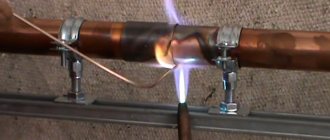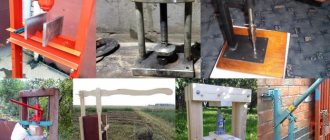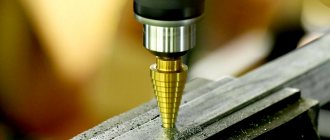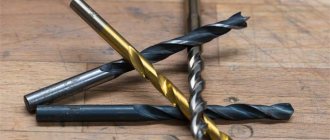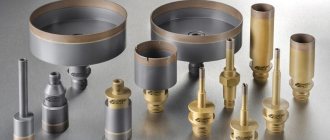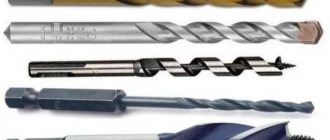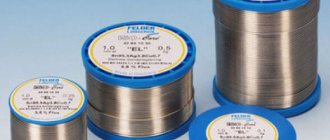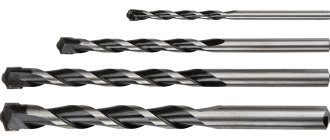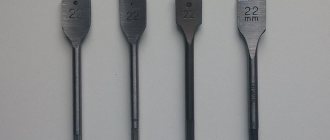A drill is a common cutting tool that is used not only to produce through holes by drilling, but also to increase the size of existing ones.
Technically, the products are attachments for hand drills, hammer drills and various machines.
Drilling itself involves removing material through the rotational movement of a sharp cutting edge.
The instrument is divided into a huge number of types according to its shape and purpose.
Drill characteristics
The main characteristic of any drill is its strength, which should exceed this indicator for the material being processed.
The tool, depending on the conditions of use, has different sizes and shapes.
The sharpening angle of the cutting part, color, etc. also differ.
Each product has a shank, the type of which must match the chuck of a drill, screwdriver or machine.
Material
For the manufacture of drills, alloys with different characteristics are used.
In this case, the so-called “high-speed” steel grades P18, P9, P9K15 are used.
If the diameter of the drill exceeds 8 mm, a welding method is used in its manufacture, for example: carbon steel for the shank, high-speed steel for the working part.
For materials with high hardness (mainly metal), cobalt drills are usually used.
Their peculiarity is that the working part is made from high-speed steel R6M5K5, VK6M with the addition of cobalt.
NOTE
After the letter “K” in the marking there is always a number that indicates the amount of cobalt in the parts.
Carbide Pobedit drills are used for drilling concrete, stone and brick.
The tip of such a tool is tipped with pobedite, an alloy of tungsten (90%) and cobalt (10%), developed in the USSR. There are more than ten modern modifications of this alloy.
IMPORTANT!
The pobedite tip does not cut the material, but crumbles it, so it is not suitable for working with metal, plastic and wood.
In addition to tungsten and cobalt, chromium, molybdenum, and vanadium are found in the alloys, and their percentage is indicated in the marking.
Coating
To extend the life of drills, their body has one of the following coatings:
• Oxide film – significantly increases resistance to overheating from friction.
Also protects the product from rust.
The service life naturally increases.
• Diamond coating is the most durable coating available.
It is mainly used on those products that are used when working with extremely hard materials, including stone and porcelain stoneware.
• Titanium coating is a general name indicating that the material contains a chemical compound of titanium - TiN (titanium nitride), TiAIN (titanium aluminum nitride), TiCN (titanium carbonitride).
Coloring
The color of the drill is very important.
It indicates the coating used or processing method:
• Gray is the native color of steel.
Indicates the absence of any processing.
The cheapest and most short-lived products are gray in color.
• Black is the color of steel that has been exposed to superheated steam during finishing.
Black products are much more durable than the previous option.
• Yellow is the color of steel that has been tempered (processing of metal to relieve its internal stress).
It speaks of the high hardness of steel, and its brittleness is greatly reduced by tempering.
• Golden – the color of titanium nitride. Bright golden tools are very durable, and they also have reduced friction against the workpiece.
Dimensions and weight
Manufacturers of cutting tools offer an impressive range of drills of every possible “caliber”, depending on the design and purpose.
Let's look at the most common spiral products according to GOST:
- Short: 20 – 131 mm in length, 0.3 – 20 mm in diameter (GOST 4010-77);
- Extended: 19 – 205 mm in length, 0.3 – 20 mm in diameter (GOST 10902-77);
- Long: 56 – 254 mm in length, 1 – 20 mm in diameter (GOST 886-77).
As for the exact weight, it depends not only on the design of the products, their sizes, but also on the material of manufacture.
The weight of ordinary twist drills usually ranges from several units to several tens of grams.
Processing accuracy
For twist drills there is such a characteristic as accuracy class:
- A - increased accuracy (10 - 13 qualifications);
- B1 – normal accuracy (up to 14 qualifications);
- B – normal accuracy (up to 15 qualifications).
Quality is a characteristic of accuracy that determines the tolerance values.
Main parts of the drill
Rice. 1 Drill parts
The main parts of the drill. The cutting part (Fig. 1). Calibrating (guiding, transporting) part. These two parts form the working part of the drill. Connecting part (neck). Tail part.
The working part, together with the cutting and calibrating parts, forms two helical grooves and two teeth (feathers) that ensure the cutting process.
The calibrating part of the drill, designed to remove chips from the cutting zone. The calibrating part has a ribbon along its entire length and, together with it, serves to guide the drill in the hole.
Sheikau drills are used for exiting the grinding wheel, as well as for marking drills.
The tail section is cylindrical or conical with a Morse taper. At the end of the tail there is a leash or paw.
Drill components
The drill has a complex structure and is characterized by the diameter and length of the drill, the width and height of the ribbon, the diameter of the back, the central angle of the groove, the width of the tooth (feather) and the diameter (thickness) of the core.
Drill diameter (d). The choice of drill diameter depends on the technological process for obtaining a given hole.
Drill strip. Provides direction for the drill during the cutting process, reduces friction on the surface of the hole and reduces heat generation.
The width of the ribbon varies from 0.2–2 mm depending on the diameter of the drill. Choose the width of the ribbon:
when processing light alloys equal
f=1.2+0.2682ln{d-18+[(d-18)2+1]1/2};
when processing other materials
f=(0.1…0.5)d1/3.
The height of the ribbon is usually 0.025mm.
To reduce friction when working on ribbons, thinning is done towards the shank, i.e. reverse taper in diameter for every 100 mm of length. For high-speed drills, the reverse taper in diameter is 0.03-0.12 mm. For carbide drills – 0.1-0.12 mm.
The drill core affects strength and rigidity and is characterized by the core diameter –dо. The core diameter is selected depending on the diameter of the drill. To increase the rigidity and strength of the drill, its core thickens towards the shank by 1.4-1.8 mm for every 100 mm of length.
The drill bridge influences the cutting process.
Drill cutting elements. The working part of the drill (see figure) has six blades (cutting edges). Double-headed cutting edges (1-2, 1'-2'). Two auxiliary edges (1-3, 1'-3') located on the calibrating part and serving to guide the drill during operation. Two transverse edges (0-2, 0-2') forming a bridge. All these blades are located on two teeth and have a continuous spatial cutting edge, consisting of five multidirectional segments (3-1, 1-2, 2-2', 2'-1', 1'-3').
Geometric parameters of the drill
The angle at the tip of the drill is 2. For high-speed drills 118-120°, for carbide drills 130-140°. The angle affects the performance and durability of the drill, the cutting forces, the length of the cutting edge and the elements of the chip section.
The angle of inclination of the transverse blade (jumper) is (=50-55o).
The angle of inclination of the helical flutes of the drill affects the strength, rigidity of the drill and chip control.
Recommended for brittle materials =10-16o, for processing materials of medium strength and viscosity -=25-35o, for processing viscous materials -=35-45o.
The angle of inclination of the helical groove in a given section x is determined by the formula
where r is the radius of the drill;
rx – drill radius at the point under consideration.
Pitch of helical grooves p.
where D is the diameter of the drill.
The diameter of the drill core - do or K is taken equal to K = (0.125...0.145) D.
To strengthen the tool, the diameter is increased to the drill shank by 1.4 - 1.8 mm per 100 mm of length.
The diameter of the back of the drill tooth q is selected according to the dependence q = (0.99...0.98) D.
Chip flute profile.
The chip flute angle θ when processing light alloys is 116o, other materials 90...93o.
The radii of the arcs forming the profile of the helical groove of the drill are taken to be equal to Rк=(0.75...0.9)D, rc=(0.22...0.28)D, and the centers of the arcs lie on a straight line passing through the center of the cross section of the drill.
Width of the feather. The width of the feather is distinguished in the section normal to the axis, and in the section normal to the direction of the chip flute, which is indicated on the drawing of the tool. The width of the blade is determined in a section normal to the axis of the drill using the formula:
Rake angle of the main cutting edges .The angle is a variable value, its greatest value is at the periphery of the drill, and its smallest value is in the center. The angle can be determined in a normal N-N(N) section. The maximum value is found by the formula
The rake angles on the transverse cutting edge have large negative values (can reach -60°). Varies according to the length of the edge. The highest value is in the center of the drill.
This leads to the following: the cutting edge does not cut, but is pressed into the metal. This consumes 65% of the axial cutting force and 15% of the torque. To reduce the axial force, the angle at the tip of the drill is reduced, while the torque increases and its cutting properties improve.
The back angle of the main cutting edges -is formed on the cutting part of the drill on the main and transverse cutting edges. It is variable and is measured in normal and cylindrical sections.
The minimum value is at the periphery of the drill, the maximum at the center. The diagram of the angles is shown in the figure. For drills made of high-speed steels, = 8-15° is accepted. For carbide =4-6o.
Changing rake and back angles during cutting. During the cutting process, the rake and back angles change and differ from the sharpening angles. They are called kinematic or actual cutting angles. The kinematic clearance angle is of greatest importance when drilling.
The kinematic clearance angle varies along the main cutting edge of the drill. Depends on the feed and the radius of the cutting blade point in question. To ensure a sufficient clearance angle during the cutting process, it is made variable along the cutting edge. At the periphery it is 8-14o, and at the core it is 20-25o depending on the diameter of the drill.
Forms of the back surface of drills. There are single-plane and two-plane forms of the back surface.
Design of the back surface along the plane. This is the simplest single-plane method of sharpening drills; it requires a clearance angle of at least 20 - 25°. With this sharpening method, the values of the clearance angle and the inclination angle of the transverse edge depend on the angle at the tip of the drill2 and the clearance angle at the periphery .
The disadvantage of such drills is the straight transverse edge, which, when working without a jig, does not ensure correct centering of the drill.
The two-plane shape of the back surface of drills includes a conical, cylindrical and helical shape of the back surface.
This form of the rear surface allows one to obtain independent values of the rear angle at the periphery , the apex angle 2 and the angle of inclination of the transverse edge .
The conical shape of the back surface of the drill is a section of the conical surface.
To form back angles, the top of the cone is shifted relative to the drill axis by an amount H equal to or greater than the radius of the jumper, and the cone axis is inclined to the longitudinal axis of the drill at an angle.
The cylindrical shape of the drill flank is a section of the cylindrical surface. This method is rarely used.
The helical shape of the back surface of the drill is a retractable helical surface. It allows you to obtain a rational distribution of clearance angle values and a more convex transverse edge of the drill, which improves the self-centering of the drill during operation.
For such drills, the values of the clearance angles on the transverse cutting edge increase, which leads to a decrease in axial loads. The big advantage of screw sharpening is the ability to automate the sharpening process.
studfiles.net
Types of drills
Products are divided into several groups according to design and purpose.
This allows you to quickly select a tool for specific tasks.
BY FORM
Based on the shape of the drill, it is quite easy to determine what material it can be used for:
Spiral
Classic instrument.
The working part has two teeth, which are twisted in a spiral.
The tool, biting into the material, pushes the chips to the surface with its grooves.
The shape of the tip depends entirely on the material for which the tool is intended.
As a rule, the diameter of products does not exceed 80 mm.
Screw
A modernized previous version, which has a more advanced form of grooves that remove chips.
Another difference is that such products are longer.
Feather
The product is flat in shape, the cutting part is made in the shape of a sharp peak, the outlines of which turn into a wider blade.
Other names are flat cutting drill, which is dictated by its shape, feather drill.
Builders call it perka.
Used where you need to get a deep and at the same time wide hole.
Ring
For those cases when you need to drill a hole with a large diameter without preliminary preparation.
More commonly known as a crown.
The shape of the tool resembles a hollow cylinder, and on the axis of rotation there is a centering twist drill.
The part that cuts the material is made either in the form of teeth, carbide tipped, or has a coating of diamond chips.
Conical (tapered)
Its shape resembles a cone with a sharp tip.
Suitable for working with metal whose thickness does not exceed 0.5 cm.
Just one tool can make holes of different sizes.
It all depends on the initial and final diameter of the cone, as well as on the immersion depth.
On the opposite sides of the drill there are special grooves with sharpened edges.
Stepped
A type of cone version.
The cone is divided into steps with increasing diameter, which have their own size.
The tool is convenient in that it allows you to monitor the diameter of the hole being formed during operation.
Spear-shaped
The shape resembles the tip of a spear, hence the name.
Used when working with hard, but at the same time fragile materials, such as glass and tiles.
Ballerina (ballerina)
Circular drill, which is used when working with wood and tiles.
It all depends on the installed cutting part.
Designed in such a way that the output is a perfectly smooth hole of large diameter.
The tool has a cross-shaped shape with cutters, the distance to which from the center can be adjusted.
This sets the diameter of the required hole.
The central part is a spiral drill, around which the cutters rotate.
Single cut drills
The cutting edges are located on one side relative to the axis of the tool itself.
In turn, they are divided into cannon type (the front end of the rod-shaped form is half cut off, which forms an outlet channel for chips)
and rifle-type (a compressed tube with a cavity through which coolant is supplied, and a groove angle of up to 120 degrees).
Tubular
Similar to crowns, but with a longer working part.
Forstner designs
An improved version of the spiral tool, but with additional cutters.
Zhirov's designs
A subtype of screw tool that has three cones on the cutting part, which is why its length is increased.
The design is also supplemented with a jumper with a groove, which is sharpened by a third of the cutting edge.
Designs by Yudovin and Masarnovsky
A tool with a large groove angle and a special shape, which distinguishes it from other types.
Countersinking
A monolithic cylinder having several cutting edges forming a cone.
Used for countersinking holes for screw heads.
BY PURPOSE
The instrument is divided according to its purpose, which is the reason for its special shape in each specific case.
The following drills are used in construction, at home and in production:
Universal
As the name implies, they cope with most materials.
They have a special sharpening, which received the corresponding name - universal.
On wood
These include spiral and feather, ring and screw.
Forstner drills and ballerina drills work well on wood, among others.
For metal
Conical, crown, stepped, as well as classic spiral.
On concrete
Crowned with carbide tipped, impact spiral and screw.
They have different shanks for hammer drill chucks.
For ceramics
Crowns, spear-shaped and ballerina.
The first ones are produced without teeth.
The cutting function is performed by a special diamond coating.
When working on glass, these are the types that are used.
For plastic
Special spiral options and crowns that can pass through material without breaking it.
There is a specialized tool that is used strictly to perform a specific task:
For deep drilling
Spiral tool with through channels.
Their purpose is to supply coolant directly to the cutting part.
This includes rifle and cannon subspecies.
Single-sided cutting
A tool whose main purpose is to create precise holes.
Subtype - ejector drills designed for drilling machines.
As the name implies, the cutting edges are offset to one side of the axis around which the tool rotates.
Centering
A specific tool capable of making only center holes in parts, but nothing more.
Selection rules
Finding a high-quality nozzle at an affordable price is not so difficult. If we are talking about trusted companies, such as Bosch, Hitachi, then with a high degree of probability the product is of high quality and reliable. To determine the quality of drills from lesser-known brands, there are several rules that can be easily checked by visual inspection:
- Geometric dimensions. The cutting edges must be symmetrical to each other and be the same size.
- Quality of sharpening of cutting edges. It is checked by touching it with your finger, similar to checking the sharpness of the blade of a kitchen knife.
- The quality of the nozzle. Any irregularities in the working or tail part should alert you. Reliable products have an almost perfect sheen.
- Metal color. An important parameter to pay attention to first is:
Gray steel is highly likely to be completely untreated.
Black - the metal is calcined with steam. This treatment increases the strength and wear resistance of the nozzle.
Golden – internal stress has been removed from the metal. This significantly increases strength.
Bright golden – the drill is coated with a thin layer of titanium nitride. It will last a long time and will cope with the toughest wood.
How to choose a drill
When choosing a good drill for your home, you should focus on the color of the product, its size, and manufacturer.
As for shanks, one of the following options occurs:
- Cylindrical (for drills);
- Conical (Morse shank);
- SDS type (for rotary hammers);
- Triangular (for hand drills), tetrahedral, hexagonal (hex for screwdrivers and drills).
When choosing a drill for professional activities, the following will be useful:
• Marking is a combination of letters and numbers indicating such parameters as diameter, steel hardness, impurities in the alloy, place of production and its technology.
NOTE
The marking is placed on products whose diameter is more than 2 mm.
• Sharpening angle – differs for different materials and is the angle between the cutting edges.
The ease of drilling and speed depend on it.
Shank
Different models of tools have different types of fastening, therefore, before choosing a drill for metal, it is worth checking the fastening method. Products are selected for the type of fastening of a specific drill. The following shank options are common:
- Cylindrical. A widely used option, used for fixation in key drill chucks. The advantage of a cylindrical shank is that it almost never jams, but due to its smooth shape it sometimes slips in the chuck.
- Hexagonal. The edges of the shank are rigidly positioned in the grooves of the three-jaw chuck. When rotating, the drill is held firmly in the chuck and does not rotate.
- Conical. A truncated cone shank is often found in drilling machine tooling. Sometimes the shank is threaded to improve retention.
Cylindrical and hexagonal shank Source instrumentgid.ru
What you need to know about drills
Morse taper type shanks are usually found on tools intended for installation in industrial machine tool chucks.
Since these shanks are available in sizes from KM0 to KM7, and the machine chuck is designed to work with one option, special sets of adapters are produced.
In addition to monolithic drills, drills with removable tips (feather drills) are produced.
As a rule, they are installed on universal CNC drilling machines.
The tips are made of various shapes from hard alloys or powder steel.
Important!
Drills coated with titanium nitride (TiN) cannot be sharpened.
Otherwise, all its strength indicators come to naught.
We drill different materials with different drills
We work on metal
1. If you need to make holes in non-ferrous metal, cast iron, steel, use spiral-type drills. The longitudinal grooves machined into them carry away the chips generated during operation. It should be noted that metal drills differ from each other not only in material and coating, but also in the type of shank. It can be made in the form of a cone, cylinder or hexagon. To attach cylindrical drills, you need a chuck; conical drills are inserted more easily - directly into the machine.
The quality of a drill can be determined by eye - to do this, take a closer look at its color. Thus, ordinary drills of low quality have an inconspicuous gray color.
But the black drill is more durable - this means that it was treated with superheated steam at the end of production.
The tool has a light shade of gold that has been treated with tempering, relieving internal tension.
And if the drill shines brightly with gold, it means it is coated with titanium nitride. Such a drill will serve faithfully for a long time, and its friction is reduced due to the coating. Although its price is higher than that of other types of drills, the quality more than pays for it.
2. Carbide drills. Since metals have different densities, different drills must be used to process them. Hard materials such as heat-resistant steel, cast iron or non-ferrous metal require the use of tools made of carbide.
3. A few words should be said about step-type drills, which appeared not so long ago. They are very convenient for drilling fairly thin sheets of plastic, tin, and roofing materials. The holes can be from 0.4 to 3.6 centimeters or even more.
Working with wood
If you need to make small holes (no more than 1.2 centimeters in diameter) in a chipboard or wooden surface, then a regular spiral drill for metal can handle these. But large holes or those that require increased precision are drilled only with a special tool designed for working with wooden surfaces. They are made from special tool steel, carbon or alloy. They are not suitable for metal.
The following wood drills are available:
1. Twist type drill bit is suitable for small and medium holes. Instead, you can take a metal drill, but the hole will turn out to be of slightly worse quality.
2. Screw drill. A single-spiral drill with a sharp cutting edge is also called a twisted drill. Due to its screw-like shape, excess chips are easily removed from it during operation. If you need to get a deep hole with smooth edges, you can't do without a screw drill.
Above is a spiral drill, below is a twisted drill bit for concrete.
3. The feather type drill is suitable for making holes with a diameter ranging from a centimeter to 2.5 centimeters. The result will not be of very high quality - rough walls, approximate accuracy. But these drills can please you with an extremely low price.
4. Crowns for wood. A drill made in the form of a crown (ring) can be used when you have to drill a hole with a diameter of up to 10 centimeters. As a rule, the set contains one shank, a mandrel and a center drill. Several crowns are included in the kit.
5. The Forsner drill has a centering point and a sharp-edged scoring tool. Thanks to it, the cutting line is accurate. For blind holes that have clear dimensions, this tool is perfect. They drill into soft wood, laminate and chipboard.
We work on concrete and brick
To comfortably work with surfaces such as brick, stone and concrete, you must have a drill with a hard tip. It is made of a special alloy, and drilling is carried out using shock-rotational movements.
Unlike conventional drills with a cylindrical shank, the drill used in a hammer drill can have a different shape in addition to the cylindrical one. These are, for example, SDS-top, SDS-max or SDS-plus. Drills with SDS shanks are used to work with rotary hammers.
1. If you need to make a medium or small hole in concrete, take a drill or drill with a carbide tip. The shape of the tool is in the form of a screw.
At the top is a concrete drill, below is a concrete drill for a hammer drill.
2. We drill a large hole with a crown, which has carbide teeth on the edge. In this case, we use the percussion drilling method using a hammer drill. You can also use a diamond-coated tool. We use either non-impact drilling with water cooling or dry drilling. The core remains inside the nozzle - a cut out piece of material.
Pobedit drills can have different quality - it depends on the brand of this material (pobedit). To drill a granite surface, you need to take a drill with plates made of medium or high hardness. Medium soft or soft plates are suitable for soft concrete or brick. This must be taken into account when purchasing Pobedit drills and drills.
We work on glass and ceramic tiles
It is more convenient to drill glass and tiles either with a crown or with a tool made in the form of a spear.
1. A spear-shaped drill tip can be either pobedite or made of tungsten carbide. In addition, there are ring-shaped drills with diamond coating. If you don’t have a special tool at hand, you can take a drill for concrete work, only a sharp one. And you have to work carefully - after all, this drill has a different shape.
A spear-shaped drill bit for ceramic tiles, and below that an annular drill bit with diamond coating.
2. But a crown for glass or ceramic tiles looks about the same as a crown for concrete work, but it does not have teeth, but only dusting.
3. The tiles can be drilled with special ballerina drills. They come in handy if you need to make a large hole. Drill carefully, from the inside of the tile, with the drill speed set to minimum.
We drill everything
Perhaps the classification of drills would be incomplete without mentioning universal drills. When finishing rooms, this tool can be used to work on almost all surfaces. Brick and concrete, tiles, wood and plastic, aluminum, steel - a universal drill can handle all of this. It also has a tricky sharpening, which, by the way, is also called universal.
Drill manufacturers
Modern, time-tested manufacturers:
- Bosch is one of the top three brands in the world for construction tools;
- Ruko – good value for money;
- Bison is a manufacturer with a good pricing policy and tool durability;
- Haisser – powerful tools for industrial needs.
Particular attention is paid to Soviet-made drills, as the most reliable and durable.
Today it is difficult to find such a tool, however, every professional knows that a tool marked “Made in the USSR” is always preferable.
HAISSER brand drills
The drill bits are marked with the HAISSER brand name to indicate that this is a titanium-coated tool that can withstand extreme loads. The titanium coating, which is applied to the surface of such drills, sharpening the pores in a cross-shaped pattern, ensures effective cooling.
HAISSER brand drills
Due to its exceptional wear resistance, durability and ability to drill with minimal friction, this tool has found wide application in various industries. The working surface of such drills is coated with a titanium-nitride coating, which also minimizes the effect of cold welding.
Such drills can be selected for making holes in parts made of different materials: alloyed and non-alloyed steels, copper, bronze, polymer materials, metal-ceramics, etc.


